
Ha Long Bay
A must-see in Vietnam Often listed as a must-see in Vietnam, Ha Long Bay (Vịnh Hạ Long) is stunning. Covering an area of 65, 650
Hanoi has all the most enticing elements found in any great Asian capital city. An enthralling barrage on the senses will greet one footstep into the city’s Old Quarter and visitors. The crumbling architectural echoes of Hanoi’s imperial history, the hum of a thousand motorbikes weaving through the ancient alleyways and the intriguing sweet and savoury scents of what must be amongst the most incredible street food scenes on the planet. Ancient gateways, intricate pagodas and tranquil temples are found throughout the otherwise hectic streets of Hanoi. Contrasts inexplicably complement one another, with peaceful lakes sitting opposite busy markets and modern malls lying next to eateries older than time. It is an adventurous dive into the deep end that will never be forgotten.
Like many of its Southeast Asian counterparts, Hanoi’s history is deep and rich – the capital of Imperial Vietnam, conquered by the French during the 19th century and a focal point of the Vietnam War towards the end of the 20th century. Ancient architectural marvels and battle scars can be seen across the capital, alongside modern developments that represent the fast pace at which Vietnam is developing. Some neighbourhoods carry strong inferences to Vietnam’s ancient dynasties, others are saturated with imposing architecture of its communist era, and some are modern and homogenised. Whether you wish to dive headfirst into a swarm of activity in the Old Quarter or stroll along one of the capital’s ethereal lakesides, Hanoi can suit the needs of anyone who ventures into its exhilarating and mystical streets.
It is Hanoi’s most popular spot in terms of attractions and accommodation. The Old Quarter perfectly embodies the merge of history and modernity prevalent in modern-day Vietnam. There is always something to be seen on the streets of this city, thanks to the narrow streets, from overlapping garish signs all vying for the most prominent spot to the free-flowing fleets of bicycles that move as naturally as running water. Watching riders circumvent obstacles – including pedestrians – as though they aren’t even there is mesmerising. All of this occurs in the setting of an ancient city home to both Vietnamese and French architecture and some of the more eclectic stores you are ever likely to come across. You can find shops dedicated to selling bamboo ladders to pirate copy DVDs to assorted bicycle parts.
Wandering through the Old Quarter’s labyrinthine streets, travellers will encounter the scent and sounds of its numerous street food vendors. In a country renowned for its street food, Hanoi offers some of the best.
Hoan Kiem Lake is located at the southern end of the Old Quarter. Overhanging trees border this beautiful urban body of water. Visitors can walk over a small bridge to the island-based Ngoc Son Temple, home to an embalmed giant turtle.
Touradar lets you compare many tour operators to find the best deals for your Vietnam vacation.

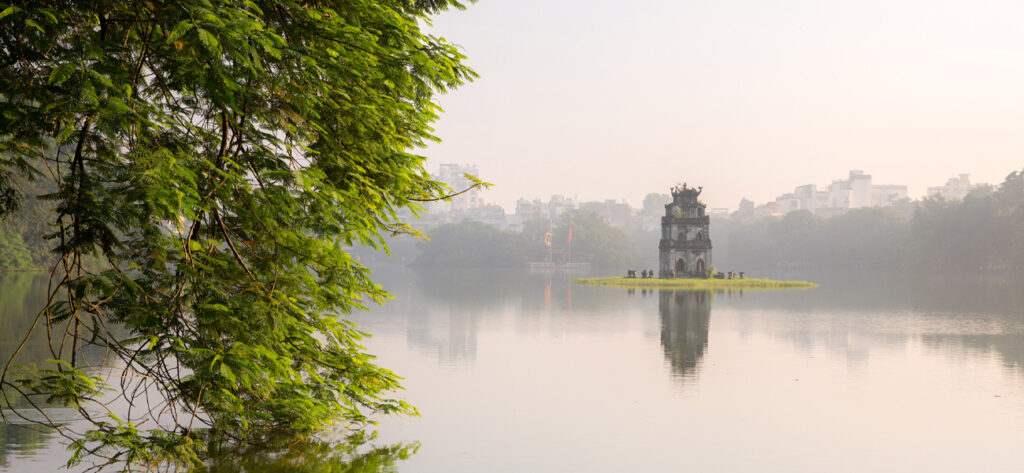

Ba Dinh is located to the north of the Old Quarter. It is quieter than its southern neighbour and is home to some of Hanoi’s most impressive historical attractions. These include the final resting place of Vietnam’s famous leader, Ho Chi Minh. The district also has several green spaces and tranquil bodies of water that inspire relaxation. They are a great contrast to the busy streets of the Old Quarter.
The utterly peaceful Temple of Literature is one of this area’s most prominent tourist draws. This charming temple complex houses Vietnam’s most picturesque and immaculately designed gardens. The imposing ochre structures of the Imperial Citadel of Thang Long and the Presidential Palace symbolise Ba Dinh’s political significance. At the same time, several local eateries and bars ensure that the area retains the humble attitude that resonates throughout Vietnam.
Visitors to the Ho Chi Minh Mausoleum should dress respectfully, covering their shoulders and knees. Security at the mausoleum is strict, and it only takes a minor excuse for the guards to deny you entry.
Check out Viator for great Wildlife Tours.
The Tay Ho neighbourhood is designed to appeal to a more upmarket, Westernised audience. This area has become popular among expatriates, thanks to its boutique shops and cafes. While traditional Vietnamese dishes such as pho and banh mi are available from roadside vendors, there is a notable emphasis on restaurants that serve Vietnamese-inspired cuisine. These establishments incorporate local influences to create meals tailored for Hanoi’s middle-class clientele.
One of the district’s primary attractions is the vast Lake Ho Tay, or West Lake, after which it was named. The lake’s extensive shoreline hosts pockets of greenery, waterfront restaurants, colonial French-style architecture, and serene temples. One such being the idyllic Tran Quoc Pagoda, whose 1,400-year-old tiered roofs take on a mystic aura when lit up at night. This is an excellent section of the city to explore if you want to take the day at a much slower pace.
To see the district from a different perspective, visit Lake Ho Tay’s vast expanse of water. Boats and pedalos are available for rent. Those interested in the Vietnam War may also wish to visit Truc Bach Lake directly to the east. US politician John McCain’s plane was shot down at this site, and a monument has been erected next to the lake to commemorate this.
We travelled to Vietnam with G Adventures.

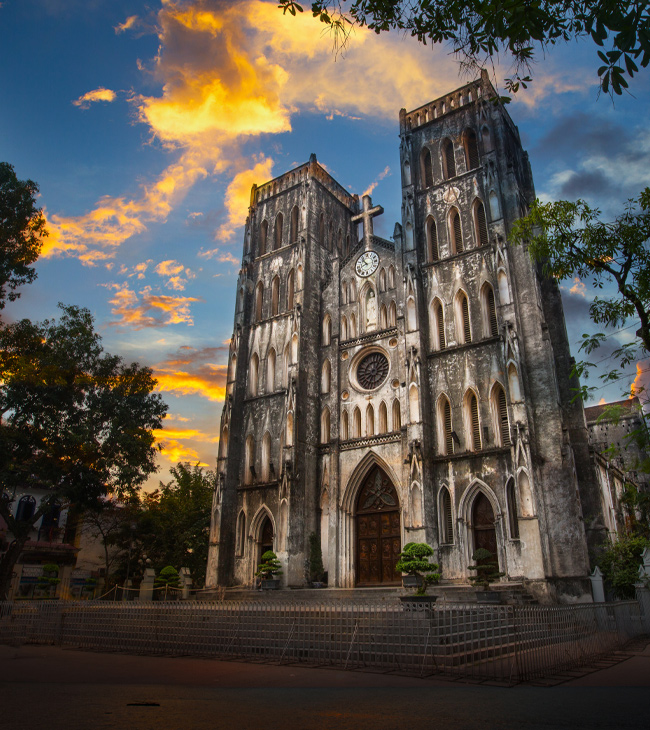
A surreal slice of France in the heart of Vietnam’s capital. At times, travellers may feel like they are wandering through the streets of Paris rather than Hanoi. Fragments of the French rule that ceased in the 1950s remain. This can be seen in its grandiose architecture, most notably the Hanoi Opera House. Based on its Parisian counterpart’s colossal columns and intricate domes, it is considered one of the city’s most beautiful buildings.
Other places of note include the breathtaking gothic behemoth of St Joseph’s Cathedral. It can be a surreal sight rising from the ramshackle typical Southeast Asian streets surrounding its giant visage. Hoa Lo Prison is also a popular stop-off. Built by the French to detain revolutionaries, it was later used to house prisoners of war during the Vietnam War. Those who wish a more thorough inspection of the country’s past should visit the National Museum of Vietnamese History. This impressive building houses several national artefacts dating back to the Bronze Age.
Anyone with a penchant for life’s finer things may wish to visit Cho Hom Market. On the upper floors, you can browse the extensive collection of fabrics, buy fabric, and ask local tailors to create clothes for you.
The market’s ground floor is home to an extensive collection of fresh food stalls, which are fun to browse.
Where to begin? Hanoi is unequivocally a contender for Asia’s most incredible street food city. Every street is home to some form of eatery. Each serves up steaming bowls of deliciously spiced goodness. They are guaranteed to draw in hungry travellers from streets away through their alluring scent alone. A simple walk from A to B will inevitably lead you past an array of dishes cooked streetside. We know you will be tempted even if you can’t identify the dish. Every dish has a distinguishable burst of succulent flavour that will have you heading back for more. Here are some of the more iconic Vietnamese dishes that we advise, nay insist, you seek out in Hanoi:
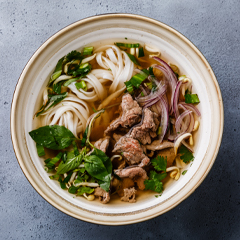
Almost certainly Vietnam’s most renowned dish, having gained global popularity in recent years. These delectable bowls of noodles and meat in a subtly flavoured broth have gained popularity with good reason. Widely available across the entire city and made fresh in front of your eyes. Delicious.

You won’t have any trouble spotting the sizzling sight of banh xeo pancakes across the capital when on the go. Made using a rice powder and turmeric mixture, these pancakes are typically filled with beansprouts, fresh herbs and prawns. The subtle crunch that each mouthful provides is sure to bring you back for more.

Banh cuon may look unfamiliar to some, but few flavours in Vietnam can compete with these delicately steamed rice rolls. It is made by wrapping minced pork, shrimp and mushrooms in a freshly prepared rice sheet. This is then topped with crispy onions and served with a dipping sauce. A northern delicacy, please get your fill while in Hanoi.

Banh mi is the Vietnamese take on a sandwich. It is thought to be a remnant of past connections to French colonialism. Freshly baked rolls with a crisp crust are stuffed with pickled vegetables, tender meat (typically pork) and the freshest herbs. The dish is considered a southern delicacy, but you can find this ideal lunch snack across Hanoi.

A dish explicitly considered to have originated in Hanoi, bun cha is a succulently spiced grilled pork patty typically served with white rice noodles and a side salad of fresh green leaves. It is not only undeniably delicious but also sure to fill you up. It is also perfect for those who have had too many bia hois the night before.

Another iconic Vietnamese dish found all over Vietnam’s capital is goi cuon. This fabulous dish consists of a fresh spring roll filled with pork, prawns, and a selection of herbs, giving each bite a satisfying crunch. The spring rolls can be eaten hot or cold and are always served undeniably fresh.

Bia hai is a draught beer that cannot be found elsewhere on the planet; it is a highly light pilsner-style lager that is usually enjoyed whilst sat on a tiny plastic stool in some nook or cranny of Hanoi’s Old Quarter. The beer is consistently brewed fresh for the day it is served, ensuring incredible refreshment after a day in the sweaty Vietnamese heat.

Vietnam is second only to Brazil in terms of international coffee production. As such, it should be no surprise that the capital is dotted with countless coffee houses. Perfect locations to sip a caphe den (a slow dripped traditional coffee) or a caphe sua (Vietnamese iced coffee made with condensed milk) as the world wanders by.
Hanoi is one of those cities with the charming benefit of all the main sites being within walking distance from the centre, meaning no real need to use public transport. That said, walking across a road in Hanoi is a skill that can take time to master. An almost total lack of traffic lights and crossing spots in Hanoi means that there is only one way to cross a road streaming with fleets of motorbikes and bicycles – just walk. As counterintuitive as it may seem, the only way to cross the road in Hanoi is to walk at a steady pace and let the traffic avoid you!
If you opt to hire a bicycle or motorbike in Hanoi, which is often a popular choice amongst travellers, be wary of the driving rules – or lack thereof. It takes an element of bravery to take on the traffic in Hanoi. Helmets are an absolute must!
Touradar lets you compare many tour operators so you can find the best deals for your vacation in Vietnam.
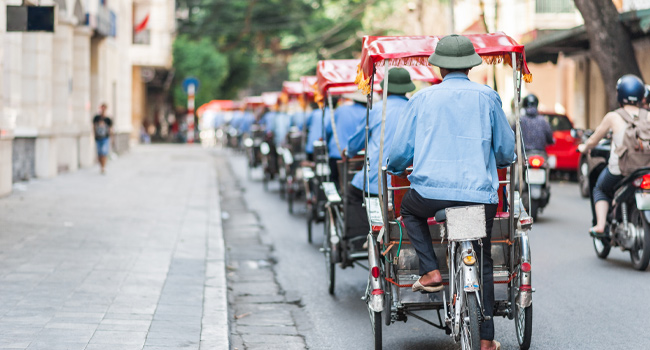
Hanoi is an amazing maze of winding historic streets dotted with a number of cultural influences and vivid echoes of its varied past, both ancient and modern. Not only this, but surrounding the city’s borders are some of North Vietnam’s greatest attractions, including the iconic Halong Bay, as well as some hidden gems that have miraculously avoided the rush of tourism that has affected so much of Southeast Asia. From Laughing Yoga to mesmeric temples, Hanoi really has it all.
Deriving from traditional puppet shows that were originally performed in the flooded rice fields of northern Vietnam during the 11th century, the show is performed on a stage of waist deep water with musicians playing live music at the side. A curtain lies at the back of the “stage” where the puppeteers operate their puppets from. The water means that the puppets appear as though floating on the water’s surface, giving the impression that there aren’t any strings controlling the figures.
Traditional stories are told through this medium as they have been for centuries, but the venues have progressed from simple rice field stages to entire theatres, such as the Thang Long Theatre next to Hanoi’s Hoan Kiem Lake, which are dedicated to performing the ancient art. It is a quintessentially Vietnamese experience that should not be missed.


Directly to the south of Hanoi lies one of Vietnam’s most atmospheric temple complexes in the form of the Perfume Pagoda. Surrounded by a dense thicket of jungle on all sides and only accessible via the Yen River, it is remote to say the least. Approaching the temples aboard traditional rowing boats builds the impression that a world undiscovered by society lies around the river’s bend. The absence of typical Vietnamese traffic also adds to the spiritual serenity of the surrounding area’s forested slopes and tranquil waters.
The moss covered steps and worn temples facades, which are thought to be centuries old, combine with the wilderness of the jungle backdrop to evoke simultaneous impressions of tranquility and adventurousness. Whilst the pagoda can be busy at times, given its popularity as a pilgrimage site, the crowds are unlikely to include too many tourists. Stroll amongst the foliage-strewn structures and breath in the cultural significance and lost-world aura that resonates through the site.
95km south of Hanoi is Ninh Binh, the capital of the eponymous region in which it sits, a region that represents Vietnamese culture at its rawest and most quintessential. Lying on a bed of amazing, jungle-coated limestone monolith valleys, which rise from the ground like emerald teeth, are waterways flanked by the iconic visage of lush rice fields. Travellers can delve deep into caves and climb steep slopes for aerial views of this region, which can only be accessed by boat – a feature that gives it an untainted atmosphere. Floating down the river between the verdant giants and carpet-like rice fields is a powerful experience in its tranquillity.
The natural spectacles of Ninh Binh offer postcard-perfect, quintessentially Vietnamese scenery, but the region is also home to impressive artificial sites. This includes Bai Dinh, the largest pagoda in Southeast Asia, and Bich Dong, a jungle-shrouded pagoda built directly into the side of a limestone karst. Another must-see in the area is the Phat Diem Cathedral, which blends the catholic faith with the curved rafters and pagoda-like peaks typical of Vietnamese architecture – an obscure yet majestic merging of cultures seldom seen elsewhere. Ninh Binh can be seen on a day trip, but an overnight stay is necessary to appreciate its wondrous treasures fully. Exploring the area on a motorbike is ideal, given the distance between the main sights.


Hanoi is home to one of the world’s most surreal streets, Ngo 224 Le Duan, known colloquially amongst tourists as “Train Street”. The narrow alley has all the characteristics expected of a street in Hanoi – cafes, small shops and rows upon rows of parked motorcycles lining its flanks – but what sets Ngo 224 Le Duan apart is the train track running directly through its centre.
This may seem like a relatively mundane aspect. However, once travellers witness a train travel down the street, missing buildings by mere inches, its bizarre nature becomes more apparent. As the train approaches the cramped street, residents take down washing, shift furniture indoors, and take cover in nearby doorways with surprising aplomb. Not only is it an intriguing spectacle to witness, but it is also a testament to the unfathomable adaptability of the Vietnamese people.
An extremely interesting museum in Hanoi that often gets overlooked. The Women’s Museum is, as the name suggests, an experience dedicated to women’s roles within the history of Vietnamese society. Covering most segments of Vietnamese society, from those who humbly worked in rural rice fields to hardworking street vendors to successful business leaders. The museum is full of intriguing narratives, straight from the subjects that are the source of its content.
Perhaps the museum’s most interesting section concerns the way in which Vietnam’s women have played the “unsung heroes” role during the nation’s various wars, embodying the sturdy determination that is present throughout the nation’s population. The museum provides a refreshing viewpoint on the history of a nation whose tumultuous past is world-renowned.
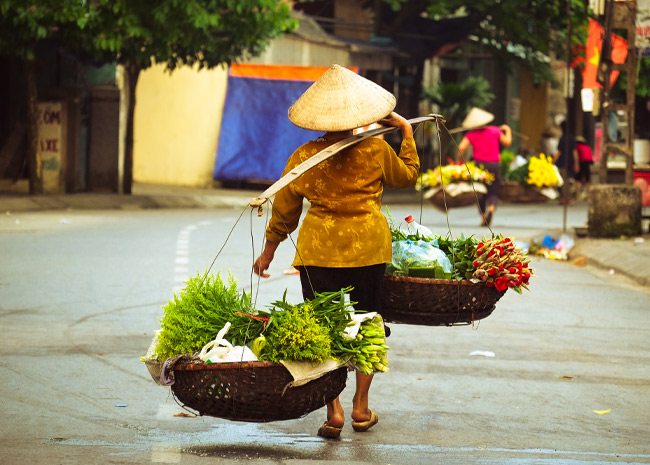

A must-see in Vietnam Often listed as a must-see in Vietnam, Ha Long Bay (Vịnh Hạ Long) is stunning. Covering an area of 65, 650
We are passionate adventure travelers who want to share the world and our travel experiences with everyone…
This website uses cookies so that we can provide you with the best user experience possible. Cookie information is stored in your browser and performs functions such as recognising you when you return to our website and helping our team to understand which sections of the website you find most interesting and useful.
Strictly Necessary Cookie should be enabled at all times so that we can save your preferences for cookie settings.
If you disable this cookie, we will not be able to save your preferences. This means that every time you visit this website you will need to enable or disable cookies again.